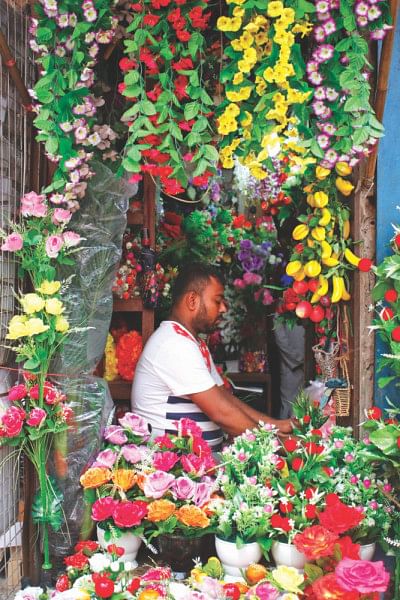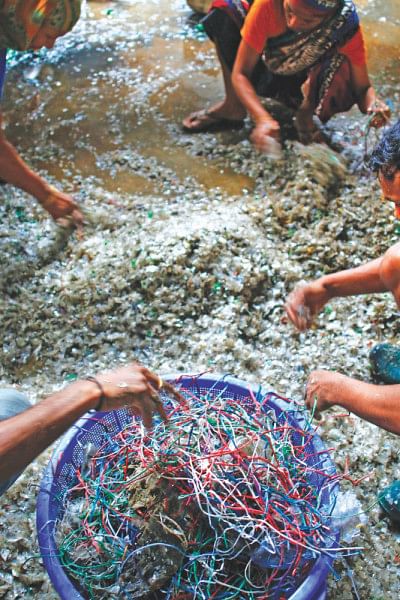From depending on it to drowning in it

Catfish, or Magur Mach, may not be a best seller in the market when compared to say a Chingri or an Ilish. However, when cooked the right way—fresh out off the pond—there are few delicacies that can beat the appetising taste of a Magur Macher jhol. Aside from the good taste, it also has medicinal values and is often prepared for pregnant women.
However, the next time you find yourself gawking at a warm dish of catfish curry, do keep in mind that there is a chance that you might end up consuming plenty of plastic along with the fish.
And it's not just catfish. A research conducted by the Environment and Social Development Organisation (ESDO) tested 100 fishes in Dhaka, with samples including Catfish, Tilapia, Pangash and Sarputi in 2016.
It found that all the fishes were contaminated with microbeads, a form of plastic. The results stated that 45 percent of the Catfish, 32 percent of the Tilapia and 22 percent of the Pangash contained microbeads.
Microbeads are pieces of plastic, which are used in soaps because of its ability to remove debris off the skin. It's also used in facewashes, creams and washing powders. Since they are cheaper than other products used for scrubbing, such as shells or seeds, manufacturers have increasingly been using this plastic as opposed to natural materials since the 1990s.
When we use these products, the microbeads end up travelling from the bathroom into the rivers where fishes end up eating them or breathing them in through their gills. According to the research in 2016, more than 6,500 billion microbeads are dumped into the water bodies and landfills of Dhaka every month.
Many developed countries have already banned the usage of microbeads in their products and the United Nations Environment Programme suggests a gradual phasing out of the usage of microbeads in cosmetics. However, the scenario in Bangladesh is quite different.

For starters, most people aren't even aware about the presence of microbeads in cosmetics—neither do they know much about its harmful impact. According to ESDO's research, in which 3,800 people were interviewed, 95 percent of the consumers did not have any idea about the harmful impact of these tiny plastic materials on health and environment. In addition, 92 percent of the retailers were ignorant about these plastic pollutants.
The Bangladesh government admits that it still has a lot of work to do as far as tackling microbeads is concerned.
“We are working on micro plastic. In America, micro plastic has been banned. It's still present in our country and we are trying to find a solution. In fact, micro plastic is also present in salt. When the plastics go to the ocean, they break, become small due to the ocean's strength and then these tiny particles mix to an extent that it's not possible to separate them. And so when salt is extracted, so is the plastic,” says Quazi Sarwar Imtiaz Hashmi, additional director general of the Department of Environment (DoE).
To be fair, there are a lot simpler problems with regards to plastic pollution that the government needs to address first before diving into the more complex world of microbeads. The absence of a formal plastic recycling system in the country is one of them. The recycling chain, according to many environmentalists isn't good enough to meet the high demand of plastic in the country.
So here's how it works. Plastic waste is collected from households through feriwalas or van collectors. These people are on the hunt for unsoiled plastic waste, which basically means that the plastic hasn't been mixed with any other waste such as oil, cream etc.
Plastic waste materials that are kept away from the normal waste often end up getting sold for a lot more money as opposed to “soiled” plastic or the ones that get mixed with normal waste. For instance, a dry polythene will always be sold at a higher price compared to a polythene mixed with other waste materials.
The feriwalas or the van collectors deliver the clean plastic to the bhangari dokan, from where it's sold to the wholesaler and then back to the manufacturer. The soiled plastic, however, end up in the landfill along with the other waste. It is here that collectors, known as tokais, go through the waste and separate the materials. The plastic that these poor individuals collect are again sent to the bhangari dokan from where a similar process is followed.
According to the DoE, the country produces around 381 tonnes of plastic waste every day, out of which around 143 tonnes can be recycled. This basically means that only 38 percent of the plastic is recyclable.
What the above also shows is that plastic recycling in the country depends mainly upon the tokais in the landfills.
Environmentalist, Dr Atiq Rahman, perhaps explains it best: “In Bangladesh, our greatest disadvantage is poverty and the greatest reason for our recycling is also poverty. Because the poor try to eke out a living out of recycling and that, in a nutshell, is the recycling process in Bangladesh. It's at a very primitive level. That is not enough,” he says.
Paribesh Bachao Andolon chairman Abu Naser Khan echoes Rahman's sentiments. “The fact of the matter is that while a certain amount of plastic waste does get recycled and end up at the landfills, there's still a huge amount of plastic waste that is unaccounted for and these end up polluting the rivers and the environment,” he explains.
According to Hashmi, the government is working on building a formal structure for recycling plastic waste. However, as of now, the most they can do is just support the tokais in some way or the other. “There are around 500 factories in the private sector which work on recycling plastic. There will be a formal sector for recycling soon,” he says.

The increase in the GDP has led to a high demand for plastic in the country, which means that a proper recycling system cannot come soon enough. According to the Bangladesh Plastic Goods Manufacturers and Export Association (BPGMEA), the country's plastic industry has been growing at about 20 percent a year. In the fiscal 2017-2018, the domestic market size of plastic products hit Tk 25,000 crore.
At a crucial juncture such as this, environmentalists and government officials believe that there needs to be a change in the mindset of the people in order to make the process of recycling plastic a lot easier. The problem needs to be sorted at the household itself.
Residents, according to Abu Hasnat Md Maqsood Sinha, the executive director of Waste Concern, need to get used to the concept of segregating their waste. “As part of a pilot project, the government tried to inspire dwellers in Chittagong and Dhaka to separate their waste based on three different materials, plastic waste, toxic waste and the rest. It gave certain areas three different baskets for the three different kinds of waste. However, it did not work,” claims Sinha.
“The idea wasn't met with enough encouragement and that's because the government didn't manage to engage with the people properly,” he opines.
DoE's Hashmi also admits that the project didn't yield any notable success.
“The bins that we had deployed were used for something else. It wasn't used properly. We did conduct a number of awareness programmes. We even trained the maids working in a number of those areas. But even that didn't work,” says Hashmi. “People's behaviour needs to change. If it doesn't, then there's no point conducting such projects,” he adds.
In comparison to the rest of the world, plastic usage in Bangladesh is still at the lower end. According to research conducted in 2015, the country's annual per capita plastic consumption is just 3.5 kgs per year. In North America and Europe, that number jumps to 139 kgs and 136 kgs respectively. However, as Sinha points out, in those countries, people don't 'sink' in waste because they have a proper waste management system.
We are living at a time when the Pacific Ocean has seen the rise of a “Plastic island” that is roughly ten times the size of Bangladesh. By 2030, we may actually find more plastic in the oceans than fish. It's, therefore, not a surprise that the theme for the World Environment Day this year is 'Beating Plastic.'
As a result of the theme, the last few weeks in Bangladesh has witnessed a number of awareness programmes and steps taken by government officials and environmentalists.
Around 100 schools were paid extra money to spread awareness about plastic pollution. Certain malls were asked to use bags made of jute as opposed to polythene.
These steps taken by the government suggest a sense of urgency. However, whether or not the DoE has a long-term plan in store to change the current scenario remains a question.

 For all latest news, follow The Daily Star's Google News channel.
For all latest news, follow The Daily Star's Google News channel. 



Comments